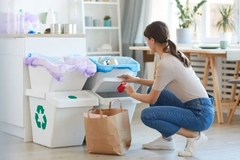Edible packaging bites into climate change and plastic pollution emergencies
15 Sep 2020 --- Edible packaging is a developing space that shows promise in combating environmental crises. A novel solution to climate change and plastic pollution could be to eat the packaging that contributes so ubiquitously to these issues. From food waste-fighting fruit coatings to seaweed-based food wrappings and potato starch noodle pouches, PackagingInsights explores edible packaging’s potential to propel zero-waste, carbon-neutral societies.
Around one-third of all food produced globally goes to waste, contributing to greenhouse gas emissions (GHG) massively, according to the United Nations Food and Agriculture Organization (FAO). In developing nations, most food losses occur during the agricultural process, while the retail and consumer level tends to be higher in middle- and high-income regions.
Meanwhile, a recent report by The Pew Charitable Trusts and Systemiq warns that Business-as-Usual could triple ocean plastic pollution by 2040, equating to 29 million metric tons of plastic leakage into the oceans at the cost of US$100 billion to the global economy.
Food waste fight
In the fight against food waste, US-based Apeel Sciences has developed a protective peel made from fruit materials added to the surface of fresh produce to slow water loss and oxidation – the primary causes of spoilage. The technology extends the shelf life and transportability of strawberries, peppers and other fresh produce, with reduced reliance on refrigeration and controlled atmosphere. Apeel has prevented over two million grocery store avocados going to waste since 2018 (Image credit: Apeel Sciences).
Apeel has prevented over two million grocery store avocados going to waste since 2018 (Image credit: Apeel Sciences).
“Apeel extends value and increases operational flexibility for growers, suppliers and retailers. Consumers have a longer window to enjoy fresh fruits and vegetables, which reduces food waste at home and in retail,” the company says.
Apeel Sciences highlights that COVID-19 disruptions have exacerbated the need to instill more resiliency in the food supply chain.
Since 2018, Apeel has prevented over two million grocery store avocados going to waste, saving enough water to fill 427 Olympic-sized swimming pools. Apeel is expanding into Europe and recently announced an avocado trial with Switzerland's largest supermarket chain – Migros.
In similar innovation, US-based Cultiva has created an edible pre-harvest biofilm that protects fruit against heat, drought and excessive precipitation. The Parka product is commonly used on cherries, apples, pears, citrus and peaches. Cultiva is testing Parka for use on other crops, including berries, grapes, nuts and tomatoes. Cultiva developed an edible pre-harvest biofilm that protects fruit against heat, drought and precipitation (Image credit: Cultiva).
Cultiva developed an edible pre-harvest biofilm that protects fruit against heat, drought and precipitation (Image credit: Cultiva).
“We have plans to develop post-harvest products using SureSeal technology to enhance shelf life even further, so there’s less waste overall and more stable food supply,” Luis Hernandez, CEO at Cultiva, tells PackagingInsights.
Seaweed successes
Beyond fresh produce, Indonesian social enterprise Evoware is providing plastic-free alternatives to singleware-use products using seaweed. The food wrappings and sachets are biodegradable, compostable, edible and nutritious, and used for a wide range of dry applications, including instant coffee, noodles or medical supplies.
Evoware’s material dissolves in hot water. Moreover, seaweed balances mechanical properties with energy efficiency and cost-effectiveness. Its cultivation does not require land acquisition or deforestation, as is often the case when land-based plants are used to provide bio-sourced materials.
Food delivery giant Just Eat conducted a six-week trial of seaweed-based sauce sachets in 2018. The Ooho Seaweed Sauce sachets, created in partnership with Skipping Rocks Lab, are edible and decompose in weeks.
Unilever brand Hellmann’s teamed up with Just Eat to trial a range of condiments in Ooho’s seaweed sauce sachets in 2019.
“The sachet doesn’t leak and is heat resistant to well over 140 °C. It can be put into a box of freshly fried chips and transported perfectly,” says Robin Clark, director of global restaurant services and sustainability at Just Eat.
Lucozade Sport grabbed headlines in 2018 by trialing drinks encased in Ooho’s edible seaweed pouches at UK running events. Lucozade Sport trialed drinks encased in Ooho’s edible seaweed pouches at UK running events (Image credit: Ooho).
Lucozade Sport trialed drinks encased in Ooho’s edible seaweed pouches at UK running events (Image credit: Ooho).
Consumer acceptance
Edible packaging suppliers agree that consumers are generally welcoming of edible solutions due to increased environmental concerns. Apeel indicates retailers are embracing its solution because “consumers prefer to just have food on their food.”
Just Eat reported that 91 percent of customers found seaweed sauce sachets to be as easy or easier to use than standard sachets, and 92 percent asked for more.
UK design student Holly Grounds – creator of instant noodle packaging manufactured from an edible and dissolvable potato starch-based film – tells PackagingInsights that she received “some extremely positive messages about the project, giving me hope that consumers will be on board.”
The noodle packaging eliminates the need for single-use plastic sachets. Moreover, spices and flavorings are set into the film, which dissolves in contact with boiling water, rehydrating and cooking the noodles with added taste.
“Others have been skeptical about the concept, as it is a new way of cooking and consuming food. However, I believe that to fight this plastic pollution emergency, we need to be more open-minded about future innovations. Sometimes what seems to be the craziest ideas make the most impact,” Grounds adds.
 Evoware provides edible, plastic-free alternatives to singleware-use products using seaweed (Image credit: Evoware).
Evoware provides edible, plastic-free alternatives to singleware-use products using seaweed (Image credit: Evoware).
Protein power
Dr. Peggy Tomasula, researcher leader at the US Department of Agriculture’s (USDA) Dairy and Functional Foods Research Department, says that more research and commitment from industry users is needed for wide-scale edible packaging rollouts.
Tomasula’s team has produced edible films from a base solution of milk casein proteins in aqueous solutions. The films are mainly made from casein-based powders with food-grade plasticizers and other additives to modify their properties. The solution can be applied as a coating on foods, filling layer in snacks with different flavors, or encapsulation vehicles for bioactive compounds.
“The films are excellent oil barriers that can be used for food products to prevent fat migration from other film layers or through food, heat sealed and vacuum-packed. We have demonstrated the films as pods for holding serving sizes of dairy powders, beverage powders and soup powders for dissolution in hot or cold water,” she tells PackagingInsights.
The edible solution maintains food structure, prevents physical damage, extends shelf life and provides a protein source when consumed. Since the films are made from milk products, they are most suitable for food products containing dairy to avoid allergy issues. Parmesan original petrochemical wrapper vacuum-packed with casein-based films (Image credit: USDA).
Parmesan original petrochemical wrapper vacuum-packed with casein-based films (Image credit: USDA).
From lab to market
Edible packaging remains small scale despite its vast potential. Grounds is developing her edible noodle packaging toward commercial launch and hopes to attract some of the big names in instant noodles.
Tomasula’s team is currently testing the films under different environmental conditions for various applications and working on scale-up for the food industry.
For Cultiva, one of the main challenges is formulation development. “Parka is a complex blend of phospholipids – to take any product from a lab environment to a scalable commercial product is a challenge when you’re going from small batches to manufacturing thousands of gallons. You need to be certain the chemistry stays consistent, scale it for manufacturing, build supply lines and establish distribution channels,” explains Hernandez.
Moreover, the Parka biofilm’s adoption requires a new mentality among growers to make decisions that help mitigate the effects of environmental stress. “Our challenge is assurance within the market to help growers understand that investing in pre-harvest applications will increase the reliability of their business,” he concludes.
By Joshua Poole











